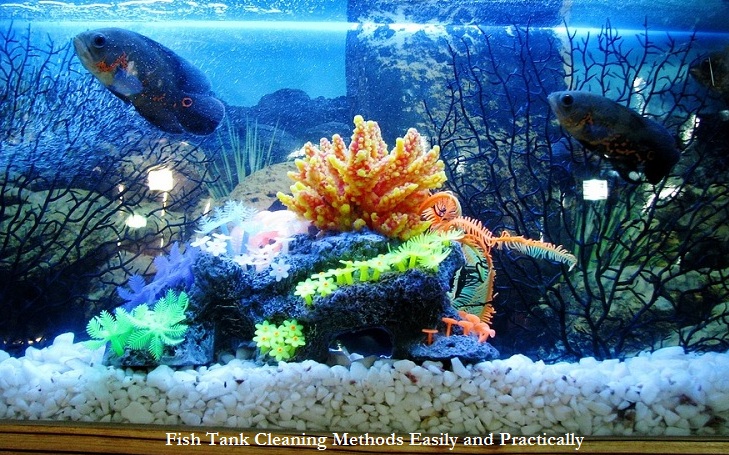Fish tank cleaning is a crucial aspect of responsible aquarium ownership. You should clean the tank regularly for your fish’s health and in good condition. By cleaning aquarium right, you will not put your fish in danger.

Fish Tank Cleaning Methods
Keeping a fish tank clean is essential for the health and well-being of your aquatic pets. Regular maintenance not only ensures a visually appealing aquarium. But they also create a conducive environment for your fish to thrive. Here are some methods for you who want to clean the fish tank safely.
1. Make a Cleaning Routine
Consistency is key when it comes to fish tank cleaning. Set up a regular schedule based on the size of your tank or the types of fish you have. Such as smaller tanks may require more frequent cleaning than larger ones.
2. Prepare the Necessary Equipment
Before diving into the cleaning process, gather the essential tools you need. Including a fishnet, algae scraper, siphon hose, and also clean buckets. Having these items on hand will make the cleaning process more efficient.
3. Remove Debris and Algae
Start fish tank cleaning by removing debris and algae. You can use a fishnet to skim the surface of the water and remove any debris. For algae buildup on the glass or decorations, use an algae scraper. Be gentle to avoid stressing the fish and damaging the tank’s interior.
If you want it to be easier and faster, you can copy the method on the Palmer Acuatics YouTube channel. Where we can use a cleaning magnet by brushing the glass walls without having to drain all the water.
4. Vacuum the Substrate
A siphon hose is a handy tool for vacuuming the substrate (gravel or sand) at the bottom of the tank. This helps remove uneaten food, fish waste, and other debris that may accumulate. Be thorough but careful not to disturb the substrate too much.
5. Partial Water Change
Regular water changes are important for maintaining fish tank cleaning. Aim to change the aquarium water every 1 to 2 weeks, depending on your tank’s specific needs. Use a clean bucket to siphon out the old water and then replace it with fresh water.
Don’t change the water all at once. This will make it difficult for the fish to adapt. Sadly, fish that cannot adapt to the new water will die. After some time, you can change the water again. Some of it too.
6. Clean the Filter Components
The aquarium filter plays a vital role in keeping the water clean. Follow the manufacturer’s instructions to clean or replace filter media regularly. This ensures optimal filtration and also prevents the buildup of harmful substances.
As a tip in a fish tank cleaning it, it is better to use cold water. For example, rainwater reservoir. You can also use tap water. By using cold water, it is safer and thoroughly clean.
Due to busy schedules, when was a beginner in keeping fish in an aquarium, forgot to clean the filter components. Because of that, the fish became cloudy and too dirty. As a result, many fish died.
7. Inspect and Maintain All Equipment
Regularly inspect all aquarium equipment, including heaters, air pumps, and lights. Ensure they are functioning properly and also replace any faulty components promptly. A well-maintained fish tank cleaning is less prone to issues.
Putting Snails in the Aquarium for Natural Cleaning
Apart from the steps above, it turns out there are natural ways to clean a fish aquarium. One of them is by placing snails. Snails offer valuable benefits to aquarium ecosystems. Their presence contributes to the overall cleanliness and balance of the aquatic environment.
One primary advantage is their role in algae control. Snails have a voracious appetite for various types of algae that tend to accumulate on aquarium surfaces. Including glass, rocks, and decorations.
By grazing on algae, they help prevent its overgrowth, healthier, and also make fish tank cleaning more practical. Additionally, snails play a crucial part in nutrient cycling. As they consume detritus and organic matter, they release essential minerals back into the water through their waste.
This natural process aids in maintaining water quality and provides a more stable ecosystem for other aquatic inhabitants. Moreover, snails are diligent scavengers, actively searching for leftover food and debris.
This scavenging behavior contributes to the reduction of potential sources of water pollution. However, make sure to choose the appropriate type of snail. Because not all snails can do this job.
By following the steps of fish tank cleaning, you can create a clean and healthy environment for your fish. Remember, a well-kept tank not only benefits the fish. But they also enhance the aesthetic appeal of your home or office. /Edit



